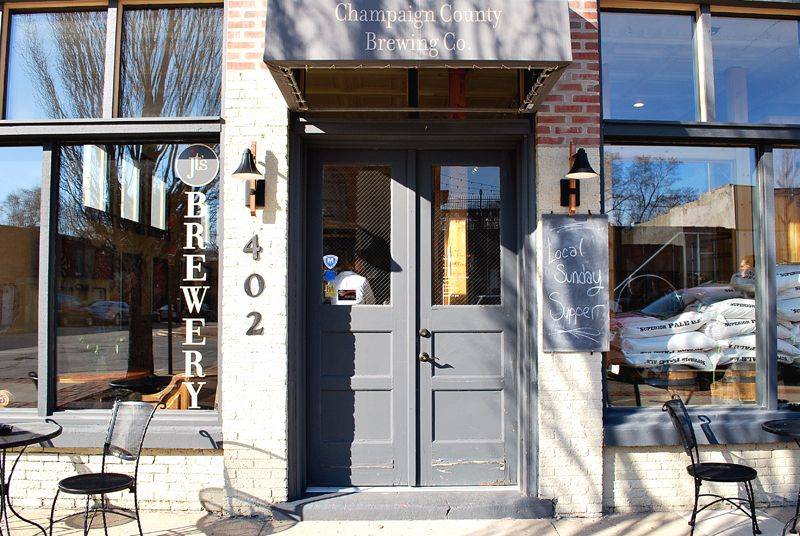Joshua and Janelle Huddleston recently formed their new catering/local food event company Eat Local. Stay Local., specializing in private functions, specialty dinners, and pop-up restaurant events. After leaving Dublin O’Neil’s earlier this year, they have since held a couple of pop-up dinner events at Sylvia’s Irish Inn in Urbana. Their most recent event was this past Sunday — a beer dinner at JT Walker’s Brewery in Mahomet. Tickets were $50 each, and this limited-seating event was a four-course dinner and pairing with JT Walker’s beer.

The unifying theme and principle for Eat Local. Stay Local. is exactly what it seems: local food and local ingredients. As Janelle stated on Sunday evening, she and Josh hope to infuse “positive energy [in]to the local economy,” by supporting local farmers and local grocers, like Common Ground Food Co-op. All of the food served at Sunday night’s dinner was sourced within 100 miles through local farms (see end of article for entire list) and Common Ground.
The dinner started at 5 p.m., and Food & Drink writer Pamela Saunders and I trekked to Mahomet on sunny Sunday evening for a spring-style, home cooked supper. I didn’t have the menu ahead of time, and was curious about what I’d be eating for dinner, but having read Patrick’s review of the December Triptych dinner at Dublin’s, knew I’d be in for some good eatin’. The dinner was incredibly delicious, and well worth a $50 ticket and drive to Mahomet. It was definitely a spring dinner, and I’m pretty sure I describe almost every course as earthy (sorry). I imagined the concept of the dinner as a journey through a spring time food chain: whole-wheat bread, greens that looked like grass, greens and carrots that a rabbit would nibble, and then me, human who eats the rabbit (and greens and carrots and bread). It makes sense in my head at least, although I’m not sure if it was intentional on the part of the Huddlestons.
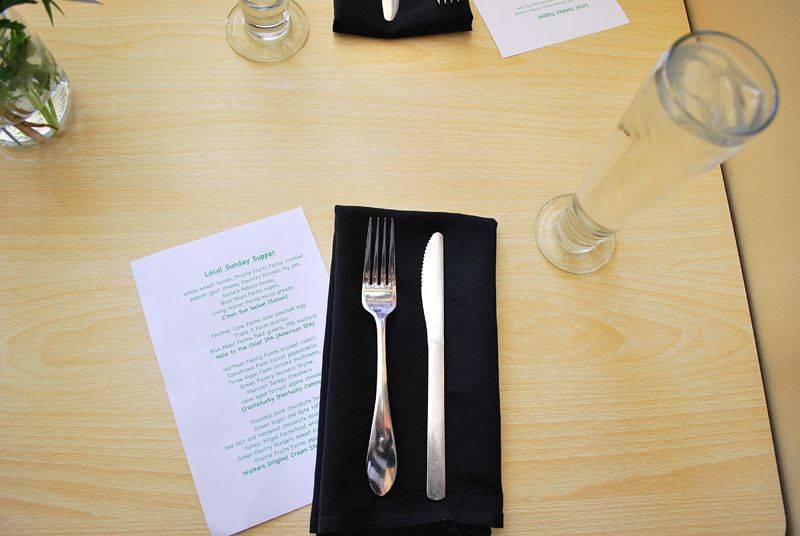
There were only a couple of hiccups (timing on expediting leading to slightly cold plates; slightly unclear menu descriptions), but despite these minor issues, the Huddlestons should be more than pleased with this event. Justin Taylor, owner and general manager of JT Walker’s Restaurant and Brewery should also feel accomplished. The beer JT Walker’s Brewery has produced was good, and paired well with the food served. All in all, it was a damn good meal. I’m looking forward to Eat Local. Stay Local.’s future events, and you can be sure we’ll announce them on SP.
Here’s what we thought of each course, including beer pairings.
One
Whole wheat lavosh, Prairie Fruits Farm cracked pepper goat cheese, Kountry 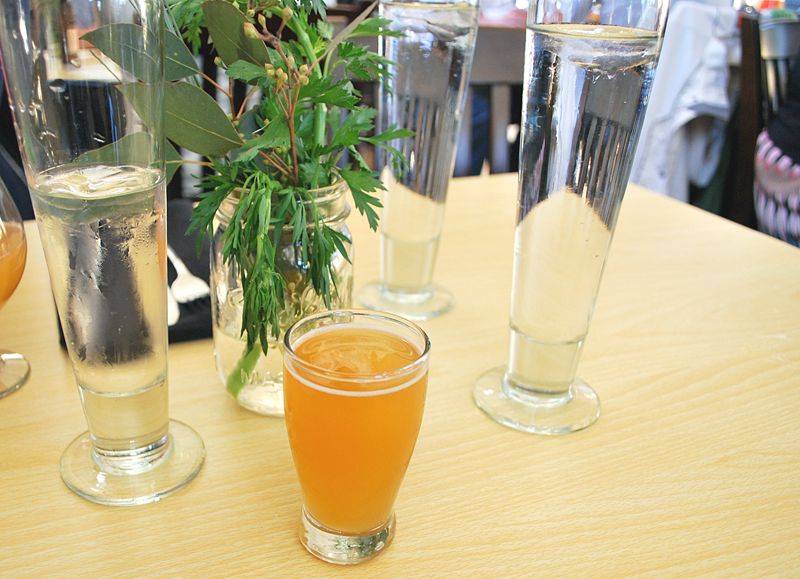 Kitchen fig jam, Sasse’s Apiary honey, Blue Moon Farms napini, Living Water Farms micro greens paired with C’mon Sun Saison (saison).
Kitchen fig jam, Sasse’s Apiary honey, Blue Moon Farms napini, Living Water Farms micro greens paired with C’mon Sun Saison (saison).
Jess: The beer was served first for each course, which gave diners a few minutes to taste and think about the beer without the sensory distraction of food. The C’mon Sun Saison was a light beer, with notes of lemon peel and pepper. It had a slightly bitter finish, and the peppery notes were clear.
The lavosh pieces (thin bread of Armenian origin, sort of like a cross between a cracker and a thin pita) were nutty and whole-wheaty. They were crispy but also a little chewy. The fig jam appeared to have been thinly spread across the top prior to baking; the sweetness was not overpowering, and it wasn’t particularly ‘figgy’. The floral honey drizzled across the lavosh and the plate certainly brought out the sweetness. The crispy napini was slightly salty, and when paired with the bright, fresh micro greens, added a nice bitterness to cut through the sweetness of the fig and honey. There was just a little nugget of peppery goat cheese on my plate; quite frankly, I wanted more. The peppery and salty cheese was delicious. This was a nice, light way to start the meal, and all of the flavors paired perfectly with the Saison.
Pam: The first course came out looking like an artfully disheveled pile of bark (it was actually fragments of lavosh, a kind of Armenian cracker), glistening with honey from Sasse’s apiary, dotted with creamy chèvre from the always-amazing Prairie Fruit Farms, and nestled in a bed of micro greens. Just like a delightful treat from the forest floor! I totally ate it with my hands. The honey was sweet (duh) but also added a perfume-y floral taste that was nicely muted by the tangy chèvre. I’m going to go ahead and call this first course an easy-breezy crowd pleaser (seriously, who doesn’t like cheese and crackers with honey?), though a little more chèvre would have taken the dish to the next level. The beer pairing was perfect — I am a saison devotee, and the C’mon Sun Saison did not disappoint. By that point I had already had a full glass of their Nine Gals Saison, too, which was ginger-y and refreshing. I’m told they are now out of the C’mon Sun Saison, so if you go you should get the Nine Gals. It’s worth a try.
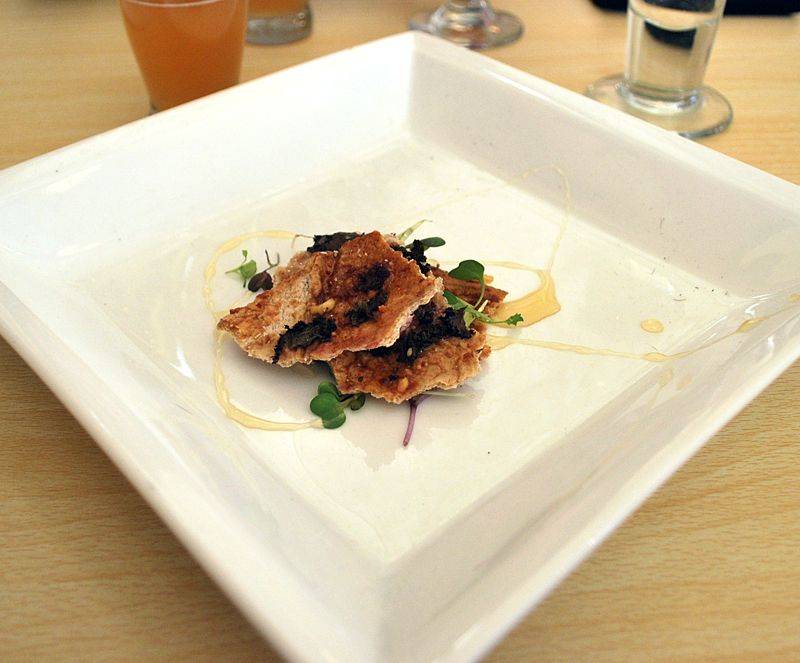
Two
Feather Lane Farms slow poached egg, Triple S Farm chorizo, Blue Moon Farms field greens, IPA mustard paired with Hale to the Chief IPA (American IPA).
Jess: This American IPA was a lovely amber color. Made with 20% corn, it was  sweeter than I expected, and as Taylor pointed out in his introduction of the beer, tends to be an IPA that IPA haters can drink. I have to agree with him. As someone who does not enjoy a bitter, hoppy IPA, this one was indeed drinkable. It was not only sweeter, but also slightly citrusy. It was the perfect match for the salad course, as the bitterness in the beer picked up the bitterness of the greens, but both were mellowed by the sweetness of the corn.
sweeter than I expected, and as Taylor pointed out in his introduction of the beer, tends to be an IPA that IPA haters can drink. I have to agree with him. As someone who does not enjoy a bitter, hoppy IPA, this one was indeed drinkable. It was not only sweeter, but also slightly citrusy. It was the perfect match for the salad course, as the bitterness in the beer picked up the bitterness of the greens, but both were mellowed by the sweetness of the corn.
This was a particularly beautiful and colorful plate of food. The greens were bright, and dressed in an IPA mustard dressing. The dressing was fairly light; it was indeed mustardy, but it wasn’t oily or heavy. The chorizo was nicely seasoned without being too salty or too spicy. The egg was nicely poached, and the runny yellow yolk dressed those greens in a way that was just naughty. This was one flavorful dish, without any one flavor overpowering the other; it was incredibly well balanced and sophisticated. I only had two complaints: firstly, it was a little cold by the time it reached my table, and I’d have preferred the chorizo warmer, and secondly, I really wanted a chunk of bread to sop up the delicious yolk-dressing residue on my plate. Other than that, this might have been my favorite course.
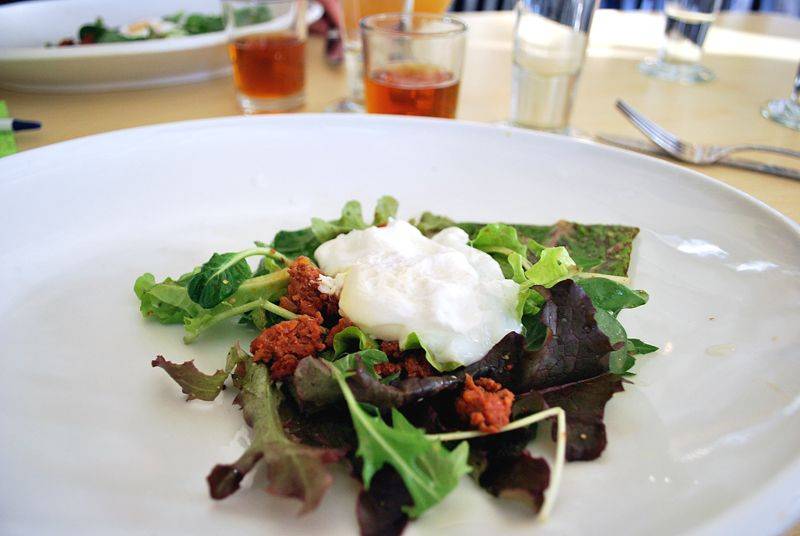
Pam: The next course was almost comically suited to my palate — chorizo (yes, please!) and a poached egg on a bed of bitter greens dressed with an IPA mustard. The pairing for this course was Hale to the Chief, a corn IPA. We were told that adding corn to the brew would bring sweetness and mitigate some of the bitter finish for which IPA’s are notorious. I am an IPA fan myself and live for that signature 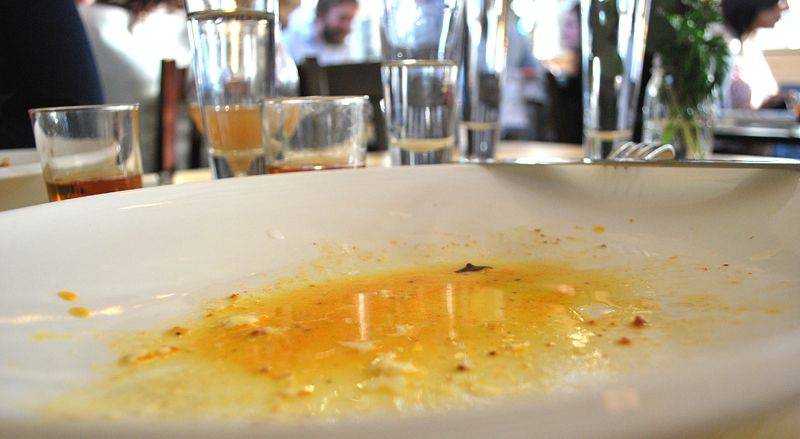 bitter grapefruit-y finish, but I think Hale to the Chief nicely balances out the more challenging flavor profile of a traditional IPA. Anyway, the chorizo was the star of this dish, and it was so tasty that I’m still thinking about it a day later. Pairing it with a creamy, oozing egg yolk was an excellent decision. The mustard and greens added a nice bite to the dish. The only thing missing was a nice hunk of crusty bread to sop up the yolk-mustard-chorizo awesomeness left on my plate.
bitter grapefruit-y finish, but I think Hale to the Chief nicely balances out the more challenging flavor profile of a traditional IPA. Anyway, the chorizo was the star of this dish, and it was so tasty that I’m still thinking about it a day later. Pairing it with a creamy, oozing egg yolk was an excellent decision. The mustard and greens added a nice bite to the dish. The only thing missing was a nice hunk of crusty bread to sop up the yolk-mustard-chorizo awesomeness left on my plate.
Three
Hartman Family Farms braised rabbit, Thomahnous Farm carrot pappardelle, Three Moon Farm shitake mushrooms, Green Pantry Nursery thyme, Marcoot Jersey Creamery cave aged alpine cheese paired with Cranetucky (Kentucky common).
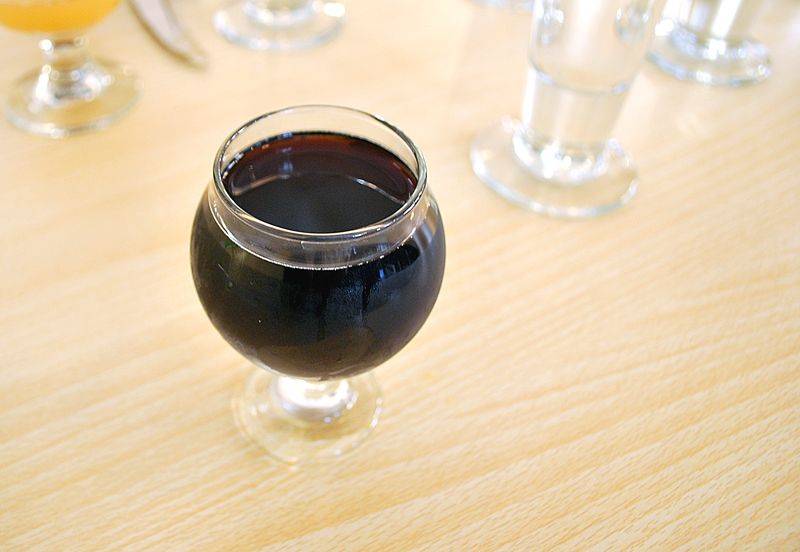 Jess: This beer was one of the more unique things I’ve ever put in my mouth, especially in liquid form. It was a sour beer with chocolate malt flavoring, and was really light and thin in consistency. It smelled and looked a little like root beer, but did not taste like it. The initial sip was a tart sourness, akin to sourdough bread, and the finish malty and chocolaty. It made me think of buttermilk-coated chocolate malt balls (like buttermilk Whoppers, or something). It’s a special collaborative brew with Crane Alley, so if you want to try some buttermilk chocolate malt balls in your mouth, you must visit JT Walker’s or Crane Alley.
Jess: This beer was one of the more unique things I’ve ever put in my mouth, especially in liquid form. It was a sour beer with chocolate malt flavoring, and was really light and thin in consistency. It smelled and looked a little like root beer, but did not taste like it. The initial sip was a tart sourness, akin to sourdough bread, and the finish malty and chocolaty. It made me think of buttermilk-coated chocolate malt balls (like buttermilk Whoppers, or something). It’s a special collaborative brew with Crane Alley, so if you want to try some buttermilk chocolate malt balls in your mouth, you must visit JT Walker’s or Crane Alley.
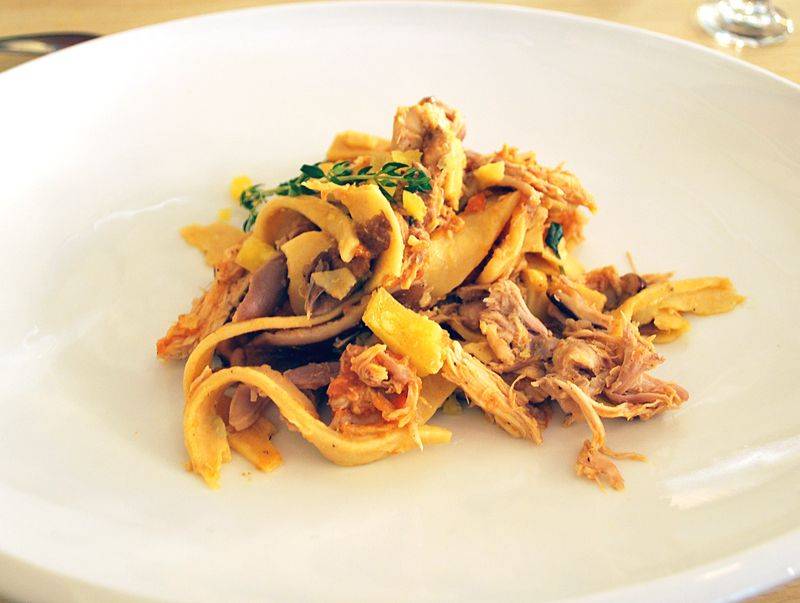
The entrée arrived shortly after the beer, and it was a lovely pile of pasta and meat in tones of orange and yellow. The dish was a little cold; with only two people expediting for a crowd of forty, I understand that timing everything was probably difficult. When I read the description of this course, I wasn’t quite sure what to expect. I thought the pappardelle would be straight up carrot, but were not. I thought that there might be some sort of sauce or braising liquid included, but there wasn’t. Despite this, I dug in quickly, and those expectations were quickly forgotten. The pasta was perfectly cooked to al dente. The star of the dish — the rabbit — was also perfectly cooked and perfectly seasoned. It was tender and juicy, despite the dish as a whole not being particular saucy. The carrot was incorporated in small pieces and as a puree. The mushrooms were left in large pieces (similarly sized to the pieces of meat), and provided a chewy, earthy textural shift in the dish. The yellow alpine cheese pieces were super sharp and a little sweet, and were the perfect sharpness needed to cut through the sweet earthiness of the other components. Despite the heaviness of the components, this dish was surprisingly bright and light. It was the right kind of comfort food for a chilly spring evening, but didn’t leave me feeling uncomfortably full.
This beer pairing was the least successful for me, and not only because I just didn’t really like the Cranetucky. I can understand the impulse to pair something a little sour with the earthy rabbit/carrot/thyme/mushroom flavor profile, but the chocolate malt notes at the end didn’t work with this sort of savory.
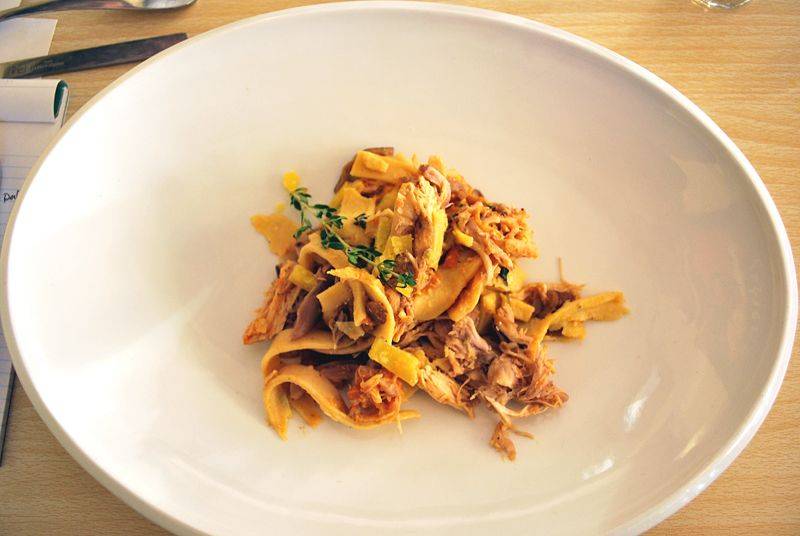 Pam: I had never had rabbit before, and I was pleasantly surprised. The meat was tender and lean — I overheard another guest say it tasted “like chicken” — and the seasoning was fantastic. The rabbit was paired with earthy vegetables — carrots, shitake mushrooms — as well as fat, doughy pappardelle noodles. It was meaty and earthy, yet also light and springy. I would have gladly eaten three times the portion we were allotted. As for the beer pairing, I found the Cranetucky (a Kentucky Common) to be a little on the bizarre side. It was described as having a sour mash and chocolate malt flavor – Jess and I agreed that it tasted a little like fizzy buttermilk. It was suggested that one must really enjoy and understand craft beers to appreciate the Cranetucky flavor profile. In that case, I better go back to beer school.
Pam: I had never had rabbit before, and I was pleasantly surprised. The meat was tender and lean — I overheard another guest say it tasted “like chicken” — and the seasoning was fantastic. The rabbit was paired with earthy vegetables — carrots, shitake mushrooms — as well as fat, doughy pappardelle noodles. It was meaty and earthy, yet also light and springy. I would have gladly eaten three times the portion we were allotted. As for the beer pairing, I found the Cranetucky (a Kentucky Common) to be a little on the bizarre side. It was described as having a sour mash and chocolate malt flavor – Jess and I agreed that it tasted a little like fizzy buttermilk. It was suggested that one must really enjoy and understand craft beers to appreciate the Cranetucky flavor profile. In that case, I better go back to beer school.
Four
Flourless dark chocolate torte, brown sugar and date toffee, sea salt and hazelnut chocolate sauce, Sasse’s Apiary honey, Kilgus Farmstead whipped cream, Green Pantry Nursery sweet basil, orange zest, Prairie Fruits Farm espresso gelato paired with Walker’s Original Cream Stout (sweet stout).
Jess: The cream stout was dark and sweet and chocolaty. It was pretty straightforward and desserty. With an ABV of 5%, it was made for drinking, and thankfully, didn’t render me incapable of operating my motor vehicle. It was, of 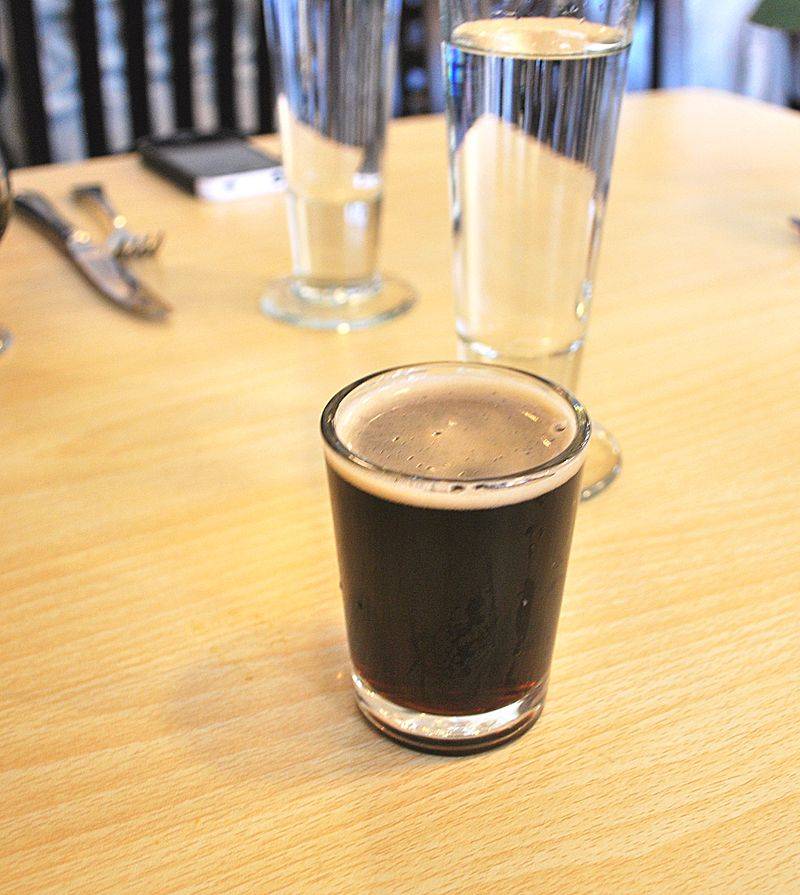 course, the perfect thing to pair with a chocolate dessert — a total no-brainer.
course, the perfect thing to pair with a chocolate dessert — a total no-brainer.
The description of the dessert on the menu card was a bit convoluted. I felt like I was having an eats, shoots and leaves moment as I read through the ingredients (?), or dish components (?), but was feeling good about all of the things listed, and eager to see how they’d manifest. As it turned out, it was an individual flourless dark chocolate torte on top of a sea salt and hazelnut spread, with a brown sugar and toffee sauce (?), one piece of chopped date, and a dollop of sweet basil and orange zest whipped cream on top of the torte. The gelato was missing, and I really don’t know what happened there.
The torte was incredibly rich and moist; the dark chocolate sang. The hazelnut spread on the bottom was delicious, and was ever-so-slightly gritty in a very pleasurable and nutty way. The brown sugar sauce was sweet and light, and may have been my favorite thing on the plate. It cut through the richness of all the chocolate nicely with its warm and sweet notes. The whipped cream was my least favorite component. I found the basil to be too overpowering, and paired with the orange zest, a very heavy-handed way to top the very rich dark chocolate torte. The slivers of basil leaves folded into the whipped cream were texturally strange, and I 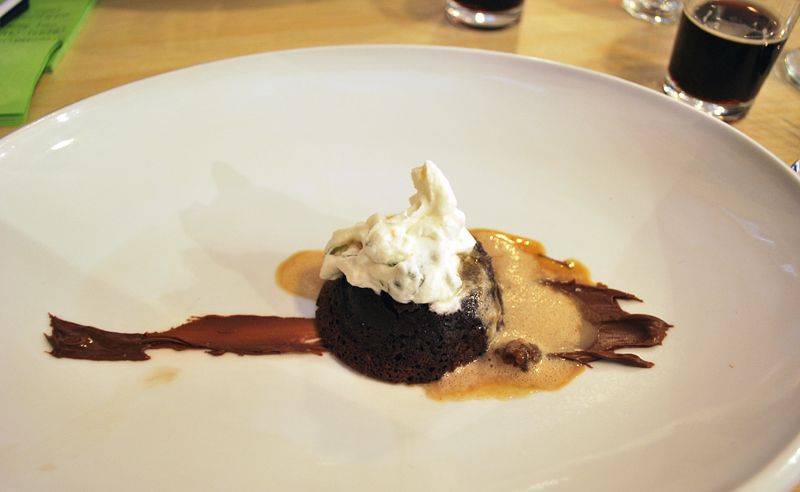 was very aware of my basil leaf chewing each time I got a bit in my bite. I would have preferred something a little lighter in flavor, perhaps just the orange zest. For the record, though, it did not stop me from eating all of it.
was very aware of my basil leaf chewing each time I got a bit in my bite. I would have preferred something a little lighter in flavor, perhaps just the orange zest. For the record, though, it did not stop me from eating all of it.
Pam: The last course was, simply put, delectable. The challenging Cranetucky was followed by the sumptuous Walker’s Original Cream Stout, which went down almost a little too easily. We enjoyed the cream stout with a petite flourless chocolate torte, covered in delicious creamy things. I was surprised and inspired by the orange zest and basil whipped cream, though do be warned that basil can be quite assertive even when submerged in cream. This dessert made me so happy, even if it did veer slightly away from the “spring” theme for the dinner. Aren’t spring desserts usually, like, a boring melon gelato that leaves you unsatisfied? This had substance and style. As with all of the courses, I was left wanting more.
Overall impression? High-quality local food. Enjoyable, non-pretentious dishes. Larger portions of everything would have been nice, especially of the rabbit, chorizo, and chèvre. I guess as a food critic you’re supposed to find oversized portions to be vulgar, but I will admit that I hit up DQ on the way home because I was still hungry. And at $50 per person, that shouldn’t happen. (PS)
Dinner Sources:
Sasse’s Apiary
Blue Moon Farms
Living Water Farms
Triple S farms
Feather Lane Farms
Hartman Family Farms
Tomahnous Farm
Three Moon Farm
Green Pantry Nursery
Marcoot Jersey Creamery
Kilgus Farmstead
Prairie Fruits Farm
All photos by Jessica Hammie.








